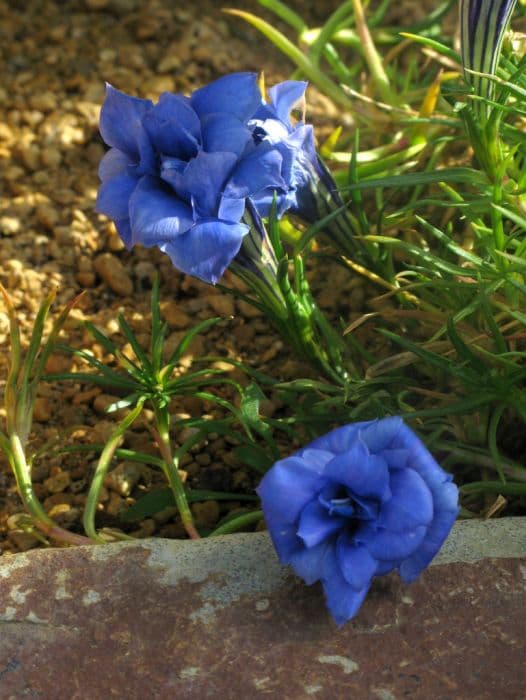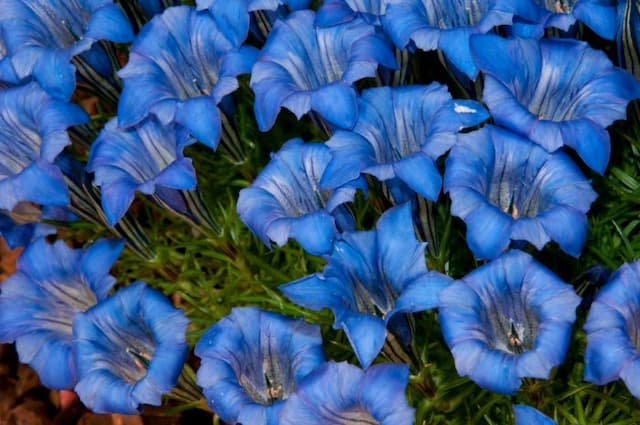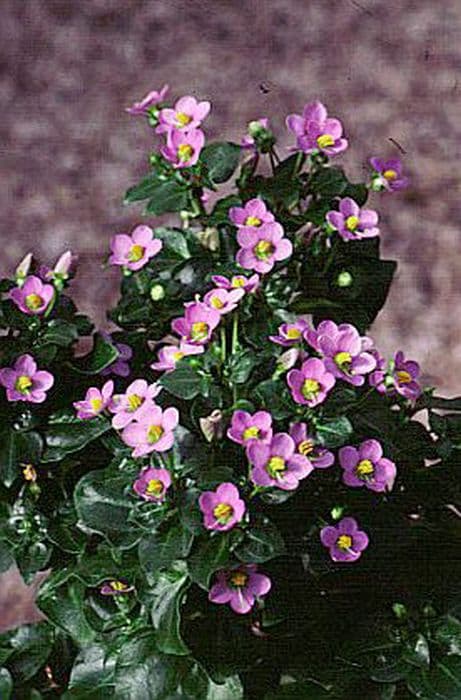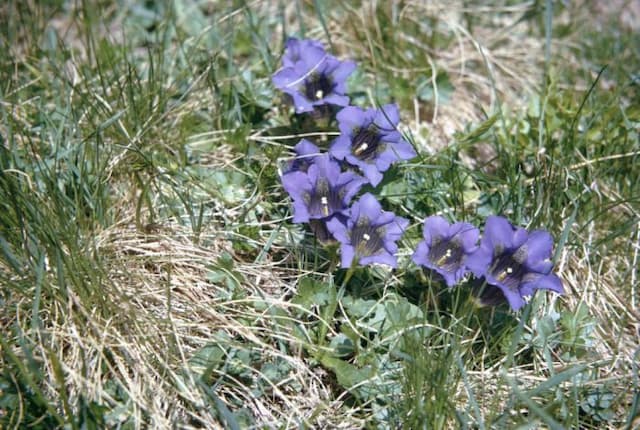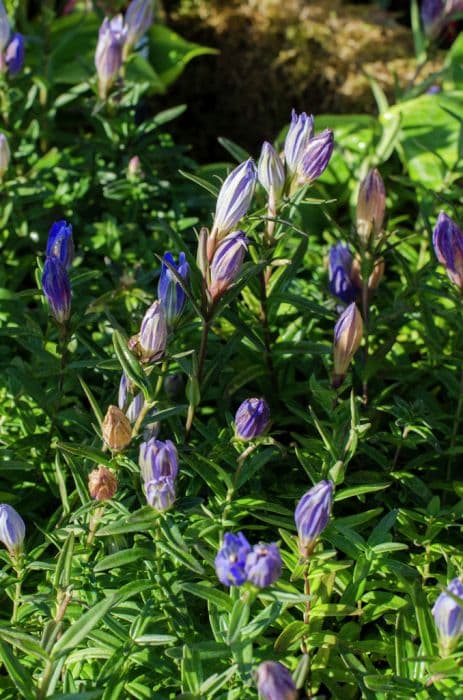Crested Gentian Gentiana septemfida

ABOUT
Gentiana septemfida, commonly known as crested gentian, is a herbaceous perennial that is prized for its intense blue flowers. The plant displays basal rosettes of lance-shaped, green leaves, which serve as an attractive backdrop to the standout feature of this species—the blossoms. These flowers, blooming in the summer months, are shaped like trumpets with deep, rich blue hues, often featuring some speckling and a lighter or white interior. The blooms are typically arranged in clusters and are noted for their fringed petal tips, giving the flowers a unique and intricate appearance. As the name "crested" implies, the petal tips have a slightly ruffled crest, adding to the decorative character of the plant. The robust and striking blooms are a magnet for pollinators, including bees and butterflies, and they make the crested gentian a favored choice for gardeners looking to add a splash of blue to their landscapes. Overall, the plant's disposition to produce such vivid blooms in a delicate, trumpet-like form is what sets it apart and draws admiration from plant enthusiasts.
About this plant
 Names
NamesFamily
Gentianaceae
Synonyms
Crested Gentian, Crested Dwarf Gentian, Summer Gentian
Common names
Gentiana septemfida var. lagodechiana, Gentiana lagodechiana, Gentiana septemfida var. orientalis.
 Toxicity
ToxicityTo humans
The plant Gentiana septemfida, commonly known as Crested Gentian, is not widely recognized as toxic to humans. There is limited information available on its toxicity, indicating that it does not pose a significant threat. Ingesting any part of the plant is generally not associated with serious consequences, but as with any non-culinary plant, consumption should be avoided due to the potential for idiosyncratic reactions or mild gastrointestinal discomfort.
To pets
Crested Gentian is not commonly listed as toxic to pets. There is little evidence to suggest that Gentiana septemfida poses a significant risk to animals. However, as with any plant not typically part of an animal's diet, it is possible that ingestion could cause mild gastrointestinal upset. It's advisable to discourage pets from consuming this or any ornamental plant to avoid any potential adverse reactions.
 Characteristics
CharacteristicsLife cycle
Perennials
Foliage type
Deciduous
Color of leaves
Green
Flower color
Blue
Height
1 foot (30 cm)
Spread
1 foot (30 cm)
Plant type
Herb
Hardiness zones
4
Native area
Caucasus
Benefits
 General Benefits
General Benefits- Ornamental Value: Gentiana septemfida, commonly known as Crested Gentian, is prized for its striking blue flowers that add visual appeal to gardens and landscapes.
- Low Maintenance: Being a hardy perennial, it does not require much care once established, making it suitable for gardeners of all skill levels.
- Pollinator Attraction: The vibrant flowers attract pollinators such as bees and butterflies, supporting biodiversity in the garden ecosystem.
- Rock Garden Suitability: With its compact growth habit, the Crested Gentian is ideal for rock gardens and alpine settings.
- Drought Tolerance: Once established, it can tolerate periods of dryness, which is beneficial in regions with water restrictions or low rainfall.
- Cold Resistance: It can withstand cold temperatures, making it a suitable addition to gardens in cooler climates.
- Soil Adaptability: Gentiana septemfida can adapt to a variety of soil conditions, although it prefers well-drained soils.
 Medical Properties
Medical Properties- Digestive aid: Gentiana septemfida has been used traditionally to stimulate the appetite and improve digestion.
- Cholagogue: It may promote the discharge of bile from the system, aiding in the treatment of liver and gallbladder issues.
- Anti-inflammatory: Compounds in Gentiana septemfida may have anti-inflammatory properties, potentially reducing inflammation in the body.
- Antipyretic: The plant has been used to reduce fever in traditional medicine practices.
- Antimicrobial: The plant may have properties that inhibit the growth of certain bacteria and other microorganisms.
- Bitter tonic: The bitter compounds in the plant can act as a tonic to strengthen and invigorate the body.
- Antioxidant: Gentiana septemfida may contain antioxidants that help to neutralize harmful free radicals in the body.
 Air-purifying Qualities
Air-purifying QualitiesThis plant is not specifically known for air purifying qualities.
 Other Uses
Other Uses- Gentians, such as Gentiana septemfida (Crested Gentian), can be used as a natural dye source due to their intense blue pigments, particularly for fabrics and textiles.
- These plants are sometimes utilized in photography and paint compositions because of their vivid colors which can inspire artistic works.
- Crested Gentian's flowers are occasionally harvested for inclusion in ornamental floral arrangements due to their distinctive and attractive appearance.
- In certain cultures, the Crested Gentian may be used symbolically in celebrations and ceremonies, representing qualities like victory or strength because of their hardy nature.
- Because of their particular growth requirements, they can be used in educational settings to demonstrate alpine plant life and adaptation in horticultural courses.
- The plant's resilience can be an excellent tool for ecological lessons on survival in harsh climates or alpine ecosystem conservation.
- Landscape designers may use Crested Gentian for rock gardens and alpine garden designs due to their ability to thrive in rocky, well-drained soil environments.
- They can be utilized as a natural indicator plant for gauging the health of an alpine or highland ecosystem, as they may only thrive in suitable conditions.
- Some enthusiasts use the consistent blooming period of Gentiana septemfida to indicate the onset of certain seasons in climate observations.
- These plants may serve as a living barrier against soil erosion on slopes due to their robust root systems and preference for steep terrain.
Interesting Facts
 Feng Shui
Feng ShuiThe Gentian is not used in Feng Shui practice.
 Zodiac Sign Compitability
Zodiac Sign CompitabilityThe Gentian is not used in astrology practice.
 Plant Symbolism
Plant Symbolism- Endurance and Strength: Owing to its resilience and its ability to thrive in difficult environments, Gentiana septemfida, commonly known as "crested gentian," often symbolizes endurance and the strength to overcome challenges.
- Victory and Achievement: The plant's nature to grow in alpine terrains where few other plants can survive makes it a symbol for victory, particularly overcoming obstacles to achieve one's goals.
- Love and Affection: In some traditions, giving a crested gentian signifies deep love and affection, perhaps due to its intense blue flowers, which can be associated with trust and deep feelings.
 Water
WaterCrested Gentian should be watered regularly, ensuring that the soil remains consistently moist but not waterlogged. During the growing season in spring and summer, watering might be required once or twice a week depending on weather conditions, with approximately 1 gallon per week for outdoor plants. In hotter temperatures, monitor the soil moisture closely and water more frequently if needed. In the winter, reduce the watering to match the plant's reduced growth rate and water only when the top inch of soil feels dry to the touch.
 Light
LightCrested Gentian thrives in full sun to partial shade. The ideal location is one where it can receive morning sunlight and some afternoon shade, especially in hotter climates. Ensure the plant gets at least 4 to 6 hours of daylight for optimal growth. Avoid placing it in deep shade as this can hinder its flowering potential.
 Temperature
TemperatureCrested Gentian is hardy and prefers cool to moderate temperatures, generally thriving between 50°F and 70°F. It can survive minimum temperatures down to about 0°F but should be protected from extended periods of freezing. The plant may not survive extreme heat, particularly above 85°F, so it's important to consider summer temperatures and provide shade if necessary.
 Pruning
PruningCrested Gentian may require pruning to remove dead or damaged stems and to encourage bushier growth. Prune in the early spring before new growth begins or immediately after flowering to shape the plant and maintain its compact form. Trimming off spent flower stems after blooming can also promote a second, albeit less vigorous bloom.
 Cleaning
CleaningAs needed
 Soil
SoilThe best soil mix for Creeping Gentian is one that is well-draining, such as a mix of loamy soil, peat, and sharp sand, with a slightly acidic to neutral pH of around 5.5 to 7.0.
 Repotting
RepottingCreeping Gentian should generally be repotted every two to three years, or when it has outgrown its current container.
 Humidity & Misting
Humidity & MistingCreeping Gentian prefers moderate humidity but is quite adaptable and can thrive in a wide range of humidity levels.
 Suitable locations
Suitable locationsIndoor
Place Creeping Gentian in bright, indirect light and cool temperatures indoors.
Outdoor
Grow Creeping Gentian in partial shade with well-draining soil outdoors.
Hardiness zone
3-7 USDA
 Life cycle
Life cycleGentiana septemfida, commonly known as Crested Gentian, starts its life cycle from seed germination in spring, after a period of cold stratification which helps break the seed's dormancy. Seedlings emerge and develop into a rosette of leaves at the ground level, beginning a vegetative growth phase where the plant establishes a strong root system. As the plant matures, usually in the second year, it enters the flowering stage during summer, producing vivid blue to violet trumpet-shaped flowers that are pollinated by insects. After pollination, the flowers develop into fruit capsules containing multiple small seeds, which are then dispersed by wind, water, or animal action. In autumn, the above-ground parts of the plant die back, but the root system remains alive and enters a period of dormancy over winter. The cycle is resumed the following spring when temperatures rise and the conditions are favorable for growth.
 Propogation
PropogationPropogation time
Spring-Early Summer
Gentiana septemfida, commonly known as Crested Gentian, is most commonly propagated through seed sowing. The ideal time to sow seeds is in the fall or just after the last frost in spring to ensure that the cold stratification needs of the seeds are met naturally. To propagate by seeds, you must first prepare a well-draining soil mix in a flat or container. Sow the seeds on the surface of the soil and lightly press them into the medium, as they need light to germinate. Covering them with a very thin layer of soil can also be done to maintain moisture. Keep the soil moist but not waterlogged and wait for germination, which can take a few weeks to several months. It's important to be patient, as Crested Gentian seeds can be slow to germinate.
